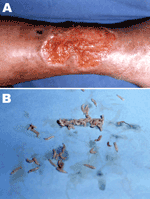Volume 16, Number 12—December 2010
Letter
Cutaneous Myiasis Caused by Chrysomya bezziana Larvae, Mexico
To the Editor: We report a case of cutaneous myiasis caused by Chrysomya bezziana larvae in a 62-year-old woman who had a complex vascular cutaneous anomaly in her lower right extremity for 8 years. On physical examination, in September 2009, she had a nonlimping walk with pink and painful feet and an ulcerative lesion on the internal surface of the right leg above the internal malleolus. This ulcer was large, clean, without evidence of infection, and had tissue in the process of granulation. Adjacent to the upper edge of this lesion, we observed a second, crater-like ulcer ≈2.5 cm in diameter from which drained an abundant, highly purulent, serohematic material (Figure, panel A).
Approximately 10 days earlier, the patient had detected discharge of worms from the second lesion, motivating her to seek medical consultation. We performed surgical cleaning and manual removal of worms (Figure, panel B) and referred the patient for external consultation to control vascular, metabolic, and parasitologic evolution and for instruction in proper hygiene. The worms were identified as C. bezziana larvae by the Parasitology Laboratory of the Microbiology and Parasitology Department, Faculty of Medicine, National Autonomous University of Mexico.
Myiasis, a zoonotic disease, is defined as invasion of human living tissue by eggs or larvae from flies of the order Diptera. Among the diverse types of human myiasis that can occur in tropical regions, those in skin tissue are the most frequent, especially those generated by flies of the family Calliphoridae, of which the predominant species are Cordylobia anthropophaga (tumbu fly); C. bezziana, and Oestrus ovis in Africa (1) and Dermatobia hominis (American warble fly) in Central and South America.
Myiases have become increasingly relevant, particularly when human activity is carried out in environments with poor hygiene or in close proximity to domestic and peridomestic animals, such as dogs and rats (2). Human myiases generally are present in cavities or wounds but also can affect tissue, such as the skin, eyes, oral cavity, intestines, or urogenital area. C. bezziana larvae can usually be found infecting wounds or cutaneous ulcers but are occasionally found in normal skin (3–5).
Tegumentary and exposed-cavity myiases are relatively easy to diagnose because the source larvae can be observed directly. As a result of the taxonomic study of the larvae based on their morphologic characteristics (6), we searched the Medline, PubMed, Scielo, and Lilacs databases for articles describing myiasis caused by the identified species. The published literature showed that no prior cases had been documented in Mexico, and only a few cases had been documented in other regions of North America.
Old World flies, such as C. bezziana and O. ovis, are the most important producers of myiasis from an economic perspective (7). The larvae feed on living tissue causing highly traumatic lesions in a great variety of warm-blooded animals. These myiases present a great diversity of clinical profiles, depending on the affected sites. Occasionally, even after elimination of the larvae, they may have subsequent effects, such as septic arthritis or even death, particularly in newborns, older persons, or immunosupressed persons (8). The spread of this infection to other countries or even across continents is not yet clear, but an overriding factor is the massive population migration, which poses the risk for introduction of new species at different places in different seasons. No reports were found indicating that this infection could be spread in another form (e.g., by food or water). Another probable cause for spread of this infection is the global change of the weather that helps larvae to survive in places where they could not previously survive (9).
In the case presented, the myiasis was limited to localized destruction of the tissue and was not associated with hemorrhagic problems or bacterial infections. However, myiasis can affect deeper structures, including striated muscle and eventually bone, causing severe destruction of these tissues. Considering the potential effects of this disease, timely diagnoses are critical to limit the damage, take appropriate hygiene measures, and if necessary, provide adequate treatment (10).
References
- Abed-Benamara M, Achir I, Rodhain F, Pérez-Eid C. First algerian case of human otomyiasis from Chrysomya bezziana. Bull Soc Pathol Exot. 1997;90:172–5.PubMedGoogle Scholar
- Mathieu ME, Wilson BB. Myiasis. In: Mendell GL, Bennet JE, Dolin R. editors. Principles and practice of infectious diseases. 5th ed. Philadelphia: Churchill Livingstone; 2000. p. 2976–9.
- Ramalingam S, Nurulhuda A, Bee LH. Urogenital myiasis caused by Chrysomya bezziana (Diptera: Calliphoridae) in peninsular Malaysia. Southeast Asian Trop Med Health. 1980;11:405–7.PubMedGoogle Scholar
- Ng KH, Yip KT, Choi CH, Yeung KH, Auyeung TW, Tsang AC, A case of oral myiasis due to Chrysomya bezziana. Hong Kong Med J. 2003;9:454–6.PubMedGoogle Scholar
- Sukontason KL, Piangjai S, Boonsriwong W, Bunchu N, Ngern-klun R, Vogtsberger RC, Observations of the third instar larva and puparium of Chrysomya bezziana (Diptera: Calliphoridae). Parasitol Res. 2006;99:669–74. DOIPubMedGoogle Scholar
- Gagné RJ. Old World blow flies (Diptera: Calliphoridae), recently established in the Americas. Bull Entomol Soc Am J. 1981;27:21–2.
- Abo-Shehada MN. Incidence of Chrysomya bezziana screw-worm myiasis in Saudi Arabia, 1999/2000. Vet Rec. 2005;156:354–6.PubMedGoogle Scholar
- Hira PR, Hajj B, al-Ali F, Hall MJ. Ophthalmomyiasis in Kuwait: first report of infections due to the larvae of Oestrus ovis before and after the Gulf conflict. J Trop Med Hyg. 1993;96:241–4.PubMedGoogle Scholar
- Sutherst RW, Spradbery JP, Maywald GF. The potential geographical distribution of the Old World screw-worm fly, Chrysomya bezziana. Med Vet Entomol. 1989;3:273–80. DOIPubMedGoogle Scholar
- Chemonges-Nielsen S. Chrysomya bezziana in pet dogs in Hong Kong: a potential threat to Australia. Aust Vet J. 2003;81:202–5. DOIPubMedGoogle Scholar
Figure
Cite This ArticleRelated Links
Table of Contents – Volume 16, Number 12—December 2010
| EID Search Options |
|---|
|
|
|
|
|
|

Please use the form below to submit correspondence to the authors or contact them at the following address:
Raul Romero-Feregrino, IDISA, Ave Cuauhtemoc 271 int 101, Mexico City 06700 Mexico
Top